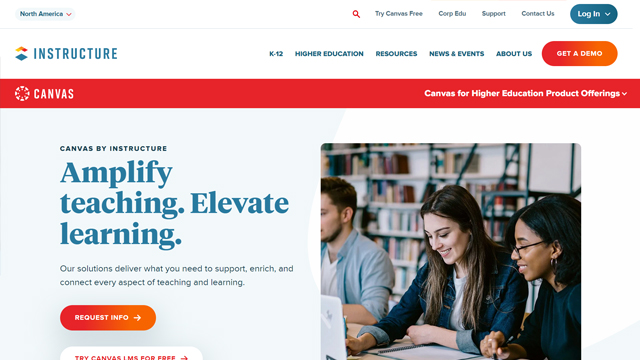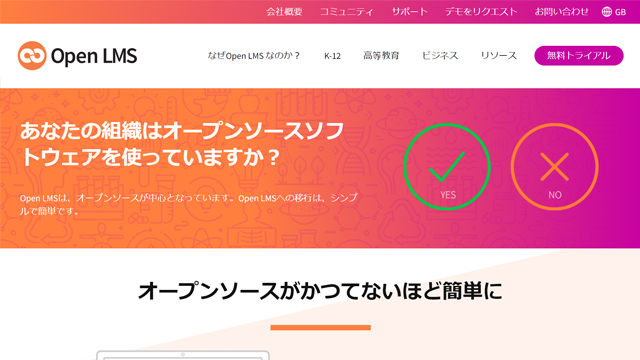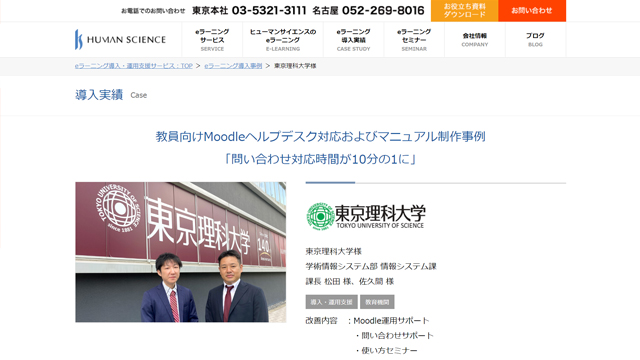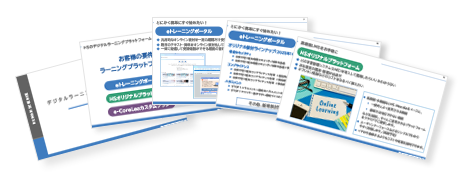2022.06.24
2024.09.02
4 Key Points for Comparing e-Learning and LMS (Learning Management Systems)
Table of Contents
1. What is an effective LMS (Learning Management System) for e-learning?
1-1. What is e-Learning?
1-2. Advantages and Disadvantages of e-Learning
1-3. Can Corporate Training be Done with e-Learning Alone?
1-4. Basic Functions of LMS
2. Four Key Points for Selecting an LMS
2-1. Is the Delivery Method Cloud-based or On-premises?
2-2. Availability of Operational Support
2-3. Pricing
2-4. Flexibility of Customization
3. Comparison of 3 LMS Options
3-1. Moodle
3-2. CanvasLMS
3-3. OpenLMS
4. Case Studies of LMS Implementation
4-1. Case Study at Tokyo University of Science – Reducing Inquiry Response Workload to One-Tenth by Utilizing Moodle Help Desk
4-2. Case Study at Mito Electronics College – Realizing Online Classes with Moodle, Enabling Class Delivery Even During School Closures
1. What is an effective LMS (Learning Management System) for e-learning?

1-1. What is e-Learning?
Without further ado, what kind of methods come to mind when you think of e-learning?
・Viewing materials provided through an e-learning system
・Watching videos on video sharing sites or websites
・Solving problems with a dedicated learning app
・Remote classes through web conferencing tools might be a bit different?
You may have many images in mind, among others.
All of them will be e-learning. E-learning has many meanings depending on the context, but broadly speaking, it refers to an educational system that utilizes IT technologies centered around computers and the Internet.
There are various means, and the content that can be learned through e-learning is diverse.
Broadly speaking, it can be classified into three categories: knowledge-based, skill-based, and attitude-based.
・Knowledge-based: Compliance, Information Security, etc.
・Skill-based: Machinery operation skills, Software operation skills, Customer service skills, etc.
・Attitude-based: Business manners, Diversity, Environmental education, etc.
(Appealing to consciousness, mind, and impression)
It is necessary to carefully plan the expression methods and delivery methods according to each classification.
Until now, the "skill-based" approach was limited to acquiring knowledge for action (+ encouraging action), but with the development of the latest technologies such as VR/AR/MR, it is becoming possible to acquire "practical skills" through simulated experiences.
1-2. Advantages and Disadvantages of e-Learning
I understand what e-learning is, but what are the actual advantages and disadvantages? Here, I would like to present it in comparison to traditional learning methods, such as face-to-face group training.
<Benefits>
●For Participants
・The achievements of the learning are properly communicated to the company: e-learning delivery and participation generally use an LMS (Learning Management System), and it is common for individual learning histories to be recorded on that server. Furthermore, administrators can refer to that data at any time, allowing individuals to be evaluated on their commitment to learning.
・Learn at your own pace, anytime and anywhere: Unlike scheduled group training with fixed dates and locations, e-learning allows you to study anytime and anywhere as long as you have a device and an internet connection. The ability to learn freely at your own pace without constraints is a significant advantage. Additionally, the ease of learning contributes to the establishment of a study habit.
・Reviewable as many times as needed: In-person training ends once the time is up. Even if you have the materials, the opportunity to be taught is only once. On the other hand, e-learning can be taken repeatedly, allowing for thorough repetition until you fully understand.
●Administrator Side
・Can deliver uniform education to a large number of learners: In group training, the number of participants is limited per session. Additionally, even with the same text, the quality may vary depending on the instructor. With e-learning, for example, the same educational content can be delivered to 10,000 learners.
・Lower cost compared to group training: According to a calculation conducted by Autobacs Seven Co., Ltd., a pioneer in the introduction of e-learning, if the educational measures that the company started using e-learning were to be conducted through group training, it would result in costs four times higher than e-learning.
・Easily add originality to educational policies: Corporate human resource development plans are best designed based on the company's challenges. Of course, it is also possible to develop original group training tailored to the company, but fundamentally, it will be based on programs from expert instructors.
The methods for procuring e-learning materials are diverse compared to that, with options such as ① purchasing off-the-shelf products, ② creating custom-made materials, ③ customizing off-the-shelf products, and ④ producing in-house (often referred to as in-house production). By combining these options, it is possible to pursue the most ideal educational measures to address the challenges of human resource development within the company.
<Disadvantages>
●Participants
・Maintaining motivation is difficult
Depending on individual characteristics, many people enjoy the lively atmosphere of group training. No matter how busy they are, they set aside work for that day and learn together with everyone. If this contrast is what motivates them in training, e-learning may feel insufficient, leading to a lack of motivation.
・Environment and devices are required to participate
In-person training can be attended with just yourself, but e-learning requires an internet connection and devices. This used to be a common issue, but nowadays, it is common for companies to provide personal computers, and many companies allow the use of personal tablets or smartphones for e-learning participation depending on their security measures.
1-3. Can corporate training be done only through e-learning?
So far, I have written about what e-learning is, as well as its advantages and disadvantages. However, a question may arise: can corporate training be conducted solely through e-learning?
To give another specific example, in e-learning, it is possible to provide a learning environment in various forms, such as posting and sharing lecture videos on video sharing sites, conducting lectures using web conferencing tools, and storing manuals in a cloud environment.
However, in corporate training, it is essential to strategically manage various means and learning content as follows to support the achievement of business goals or individual goals that the company aims to achieve.
・Visualize and evaluate each individual's learning status to benefit the business
・Deliver materials only to those who need them at the right time
・Organize multiple materials into courses for planned implementation
・Maintain motivation for learning
The LMS (Learning Management System) can be utilized to achieve these goals.
1-4. Basic Functions of LMS
LMS stands for Learning Management System, which is translated as Learning Management System in Japanese.
LMS is a system that centrally manages information such as learners, materials, progress, and grades necessary for e-learning.
In recent years, there has been an increase in systems that can operate not only as simple management tools but also as Learning Experience Platforms (LXP) that integrate employee performance management and provide tailored learning experiences for each employee.
> Moodle Basic Course: What is Moodle?
<Functions for Participants>
・e-Learning Delivery: Deliver "specific materials" to "designated participants" for a "specified period" and require them to take the course. There are various functions such as automatic delivery settings that can send course notifications when conditions like target audience and date/time are specified, and security settings that restrict participation to internal network environments when taking lectures that handle important company information.
・Submission of assignments, tests, and surveys: You can collectively implement and manage submissions before and after the lectures.
・Group Training Management: Participants can easily check the content and apply for participation on the system, as well as conduct pre-surveys, attach materials, and centrally manage traditional tasks.
<Administrator Functions>
・Organization Management: Set up the corporate organizational chart within the LMS to facilitate the extraction of target individuals such as departments and divisions.
- Report creation and management: This feature allows you to conduct surveys and submit reports on the LMS. After training sessions, it is common to collect surveys and assign report tasks, but aggregating and consolidating such data can be cumbersome, and reminders for those who have not completed them can add unnecessary pressure. With the survey and report features in the LMS, you can automatically distribute surveys at the end of e-learning or training sessions and manage report submissions collectively on the LMS.
・Social Features: A communication function similar to a social networking service that can only be used by employees. Learning is not necessarily a one-way process from educators. It can also be considered learning when individuals share their knowledge or engage in discussions, deepening mutual insights. In recent years, terms like "social learning*" have gained attention, and some LMS have features that enable this.
Unlike one-sided education that clarifies and fixes the roles of the teacher and the learner, this approach is characterized by participants teaching and learning from each other interactively through a network. In companies, by sharing knowledge with each other within the organization or beyond, each employee fosters innovation and improves performance.
Reference URL:
Digital Learning Consortium (DLC)
e-Learning in Corporate Education Basics ① (Introduction) | e-Learning Blog | e-Learning by Human Science (hs-learning.jp)
2. Four Selection Points for LMS

Have you ever been confused by the amount of information when looking at product introduction pages or comparison sites while implementing an LMS? Even after comparing and considering a lot of information to make a decision, it can be difficult to determine which option is the best, and the selection process may not progress.
In such cases, how about clarifying the purpose of implementing an LMS and what you want to achieve, then narrowing down the necessary conditions for your company and proceeding with comparisons and reputation checks for selection?
I believe there are companies that are newly engaging in e-learning as well as those that are already involved in e-learning but wish to improve certain aspects, and I think each company has its own purpose for implementing an LMS.
"There is a knowledge gap among members, and it cannot be said that the operations are efficient. Regardless of skills, is there a way to standardize knowledge and know-how?"
"In recent years, there has been a lot of movement of people, and time tends to be consumed by education. It's an important phase, but if there were an easier way to do it..." strengthening of knowledge management
"I want all employees to engage in compliance training with a sense of ownership, but the necessary training content varies depending on their positions, and it is currently difficult to continuously implement this due to internal adjustments, so I want to find a solution."
"Compliance-related values change significantly with the times. Updating educational content tends to take up a lot of time..." compliance education
I think the educational content is somewhat in place, but employees are not engaging with it enthusiastically. I want to be able to manage the learning environment and motivation.
I believe there are various purposes.
These purposes are addressed by the functions described in [1-4. Basic Functions of LMS].
If so, what points should we compare to select an LMS?
Therefore, I would like to touch on selection points other than functionality from here.
2-1. Is the delivery format cloud-based or on-premises?
The first point is the delivery format. The delivery formats of LMS can be broadly divided into two categories: "on-premise" and "cloud." In simple terms, their meanings are as follows.
On-premises: This refers to a method where IT resources such as servers are installed within the company or in a data center, and users manage and operate them themselves. It is also referred to as "company-owned" or "in-house operation."
Cloud: This refers to a method of using IT resources provided by cloud vendors over a network and paying fees based on usage.
The main difference between on-premises and cloud is that you do not own servers or packaged software. Since you can use resources without owning them, as of 2022, it has become standard practice to consider using cloud services first when building new IT systems, a concept known as "cloud-first".
In the construction and maintenance of information systems, this approach is further advanced, and the use of cloud services is positioned as the "first choice (default)". This policy is referred to as the "Cloud by Default Principle".
Reference Material: "Basic Policy on the Use of Cloud Services in Government Information Systems"
Therefore, I would like to look at the advantages and disadvantages of cloud compared to on-premises here.
<Benefits>
・Low initial costs
・Costs can be kept down as it is a pay-as-you-go service
・Billing stops when the service is no longer used
・Can be started immediately without hassle
・Data is protected and accessible even during disasters
・The cloud service provider ensures server security, thus
the security risks are lower than managing it in-house
<Disadvantages>
・Ongoing operational costs, and a shortage of personnel for cloud operations
・Limitations on customization
・Some services may not be compatible (such as legacy systems)
・Services may be disrupted if partner services are affected during disasters or emergencies
・Since it involves using third-party services, security standards cannot be controlled by ourselves
What is mentioned here is generally said during system implementation, so please check with the cloud vendor as it depends on the service contract details.
> Benefits and Considerations of Moodle Cloud Services
> Growing Demand for Cloud Services in e-Learning Systems (Moodle, Totara)
> Moodle Cloud Services (e-CoreLea)
2-2. Availability of Operational Support

It is important to choose a vendor that provides solid support not just for the initial implementation but also for ongoing operations. Regardless of whether the services are paid or free, it is recommended to select a vendor that offers services such as maintenance after implementation, help desk support, and outsourcing of operational tasks.
> Moodle Implementation, Seminars, Manuals
> Moodle Maintenance and Operations
2-3. Fees
Finally, we will touch on pricing, but unless you are looking for extremely low costs, it is safer not to rely too much on price information at this stage. This is because, in many cases, the costs of an LMS are divided into "initial costs" and "monthly usage fees," and especially the "monthly usage fees," which fluctuate every month depending on usage, cannot be estimated without narrowing down the requirements further. Moreover, the way vendors list their services on comparison sites and whether they are listed at all varies, making it impossible to compare under the same conditions. Additionally, the pricing aspect can also depend on negotiations. If you set price as a condition from the start, you may overlook an LMS that is suitable for your company.
Rather, it is more efficient to narrow down vendors that meet the necessary conditions for your company's human resource development and request information and preliminary estimates.
2-4. Flexibility of Customization
Recently, there has been an increase in companies that prioritize cost and speed by creating e-learning educational content in-house. In response to this, various LMS vendors are providing features for content creation or offering content creation tools (in-house support tools). If you want to create educational materials in-house, it would be beneficial to include the presence or absence of these tools as screening criteria. Once a system for creating educational materials is established, the flexibility of educational policy content will significantly increase, leading to substantial cost savings in the future. We highly recommend considering this.
> What is Knowledge Management?
> Three Important Reasons for Education in Compliance Measures and Effective Methods
3. Three Selected LMS Comparisons
Now that we have learned about general LMS, I would like to compare using actual LMS as examples from here on.
There are many LMS options available, but if you want to "keep initial costs low" and "do not want to change your company's training style," an open-source type is recommended.
If it is open-source, the basic features can be used for free, which helps to reduce initial costs. Additionally, since templates can be freely constructed to match your company's training style and management system, it is possible to build an e-learning system that is optimal for your company.
3-1. Moodle

<Features>
Moodle is an open-source e-learning system with over 250 million users combined from educational institutions and businesses.
A major feature is its high level of customization. Flexible customization tailored to the individual goals and needs of each course is possible, allowing it to accommodate any class size, from small courses to large ones.
In addition, it comes with a highly versatile editor that allows for easy incorporation of images and videos, making it simple to create teaching materials. Furthermore, it is compatible with smartphones and tablets, enabling participants to comfortably attend lectures anytime and anywhere.
<Features>
・Compatible with smartphones and tablets
・Calendar function
・Check learning progress
・Customizable with logos and color schemes
・Multilingual support
・User permission restrictions
・Regular security updates
・Course and participant group management
・Grade management
・Evaluation function using rubrics
> [Moodle Basic Course] What can you do with the e-learning management system Moodle?
> [Moodle Basic Course] What is Moodle?
> [Moodle Basic Course] Moodle's Security Measures
> [Moodle Basic Course] What can be done with Moodle's default features?
3-2. CanvasLMS
 Image source: INSTRUCTURE
Image source: INSTRUCTURE<Features>
The Canvas LMS interface is designed to be simple, allowing anyone to use it without confusion. Since it is a foreign product, there may be concerns about the translation of the interface, but the Japanese translation is mostly at a level where the meaning is understandable, so you can feel at ease.
In addition, it can import participant information such as user information and enrolled courses in CSV format, allowing for a smooth transition from the current system, and it also excels in integration capabilities with other systems. By integrating with the webinar system (BigBlue Button), it is also possible to hold webinars within the system.
With features convenient for training in webinars, such as resume usage, recording functions, group chats, and shared notes, training can be conducted more efficiently, and high learning effectiveness can be expected.
<Features>
【Administrator Features】
・User management for administrators, instructors, and participants
・Partial management authority granted to general users
・CSV import functionality for various information
Features for Instructors
・Creation and correction of teaching materials and tests
・Confirmation of student attendance
・Grade management
・Creation of logs
・Course discussions
Features for Participants
・View information about the courses taken
・Upload assignments
3-3. OpenLMS
 Image source: Open LMS
Image source: Open LMS<Features>
This is a cloud-based Learning Management System (LMS) built on Moodle, the most widely used platform in the world. It features a sophisticated user interface design that is intuitive and easy to use, even for those unfamiliar with LMS operations, and includes many convenient functions for analyzing learning progress and outcomes.
<Features>
・Compliance Tracking
・Course Tracking and Management
・Social Learning
・Learning Paths
・Simultaneous Learning
・Portal Site
・Mobile Learning
・Built-in Course Creation
・Certificates and Licenses
・Group Training
・Asynchronous e-Learning
Reference URLs
What is Moodle / Benefits / Features | No.1 in Domestic Achievements of Human Science (science.co.jp)
Moodle Association of Japan (moodlejapan.org)
Open LMS: Moodle-based Cloud Learning Management System | Assist Micro Co., Ltd. (assistmicro.co.jp)
Canvas LMS (Next Generation Global Standard e-Learning System) - Bownet Systems Co., Ltd. (bownet.co.jp)
4. Case Studies of LMS Implementation
We will introduce our achievements in human science.
4-1. Case Study of Tokyo University of Science - Reducing Inquiry Response Workload to 1/10 by Utilizing Moodle Help Desk

Background of Introduction
・Due to the COVID-19 pandemic, the format of classes changed, and especially from the immediate aftermath of COVID in 2020, classes were switched to 100% online. Asynchronous classes using an LMS (Moodle) have increased, allowing students to learn assignments, materials, videos, etc., regardless of class time.
・Moodle had been implemented previously, but at this timing, there has been a significant increase in inquiries from faculty members who are using Moodle for the first time, and the responses were being handled by the staff on campus.
However, including basic inquiries, there were over 100 inquiries per month, making it difficult to handle them solely on campus.
Therefore, we ended up looking for a company that could provide help desk support, and we found Human Science, a Moodle partner company, on the Moodle homepage and reached out to them.
Reasons for Selection
Inquiries were made to three Moodle partner companies, including Human Science, for comparison and consideration.
The partners were selected mainly for the following reasons within the niche business of Moodle operation and maintenance.
・A reliable company size
・Numerous achievements in operation and maintenance at universities
・They provided a price that met our budgetary conditions
Furthermore, not only do we provide help desk support, but we also have strategies to reduce inquiries themselves, such as:
・Usage seminars (online training)
・Improvement and translation of manuals (Japanese and English versions)
・Video manual production
・Moodle server setup and performance investigation
It has become a key point for our clients that we can handle these services in a one-stop manner.
<Implementation Results>
Inquiries handling, during busy times, reduced from 100 hours/month to 10 hours, significantly decreasing the workload.
・It was great that the content went beyond just answering inquiries and included suggestions as well.
・Regarding the manuals, in the past, there were voices saying they were "difficult to understand" and "hard to read," but now that improvements have been made, those issues have disappeared.・Originally, the Moodle manual was in PDF format, making it difficult to find information among the vast number of pages. However, after the revision, it was restructured using Moodle's book feature. As a result, it was improved to a more user-friendly format that is easily viewable online from a browser, leading to better usability and a reduction in complaints from instructors.
・There have been requests for the English version of the Moodle manual for some time, but we had not been able to address this properly until now. This time, by providing the English version of the manual, it was our first response to this request, and it was very well received as it had been a long-standing demand.
- Video manuals are being effectively utilized. I believe that having a well-organized set of content for faculty to review, along with a decrease in inquiries, is a significant benefit.
For details on Human Science Moodle implementation support, click here
> Moodle Implementation and Operation Support Services
> Moodle Implementation, Seminars, Manuals
> Moodle Maintenance and Operation
4-2. Case Study of Mito Electronic Vocational School - Realizing Online Classes with Moodle - Enabling Class Delivery Even During School Closures

<Background of Introduction>
Due to the declaration of a state of emergency, we were forced to close schools even right after the new students enrolled. At that time, face-to-face classes were the main focus, but starting around February, when the impact began to be felt, we started gathering information about e-learning that could provide classes online and contacted your company.
Reasons for Selection
We considered multiple e-learning systems, but we decided on Moodle for the following reasons:
・It is open source and the implementation cost is reasonable
・There is a wealth of manuals available online
・It has a high market share in universities
We also considered multiple partners. The reasons for choosing Human Science are as follows:
・Good response during inquiries
・The proposal of plans tailored to the size of the school (up to 200 people)
・The extensive track record of operation and maintenance at universities
<Implementation Results>
・During situations where students cannot attend school, such as school closures, we utilize tools for remote online learning the most. When a school closure occurs, if we interrupt the classes that have been conducted until then and start preparing to transition online, there will inevitably be a time loss. However, by having regular classes in a hybrid format in advance, we can create a system that allows for a smooth transition even during school closures.
・Classes are mainly conducted in person, but we are exploring hybrid methods such as showing preview videos and implementing flipped learning. We are making efforts to enhance the quality of our classes while seeking ways to do things that cannot be achieved through in-person classes alone.
It was also good that communication regarding classes could be made to students outside of class hours, allowing for asynchronous communication related to the classes.
> Support and Manual Creation for Faculty Moodle Help Desk
> Enabling Online Classes with Moodle, Making Classes Available Even During School Closures
For details on Human Science's Moodle implementation support, click here
> Moodle Implementation and Operational Support Services
> Moodle Implementation, Seminars, Manuals
> Moodle Maintenance and Operations
> Moodle Implementation Support Costs
You can see other cases of Moodle implementation in this article.
> Moodle Implementation and Operational Support Achievements
Human Science offers a variety of services to help our clients implement and operate e-learning. Please feel free to contact us if you have any concerns.
> e-Learning Content Production
> e-Learning Material Translation
> In-House Material Development Support
> Articulate Storyline, Studio Implementation Support and Production Outsourcing Services
> Microlearning Implementation Support
> Flash to HTML5 Migration and Conversion
> Moodle and Totara Learn (Open Source LMS) Implementation and Operational Support
Contact form is here (https://hs-learning.jp/contact/)
Moodle Related Information
- 2025.10.29
- [Moodle Manual ⑤] 2025 Edition|Support Staff Explain How to Set Up and Utilize Groups/Groupings!
- 2025.10.28
- Can You Obtain Qualifications Through e-Learning? Examples of Qualifications and Their Benefits












